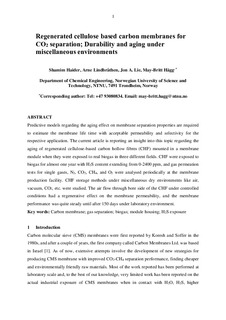| dc.contributor.author | Haider, Shamim | |
| dc.contributor.author | Lindbråthen, Arne | |
| dc.contributor.author | Lie, Jon Arvid | |
| dc.contributor.author | Hagg, May-Britt | |
| dc.date.accessioned | 2019-02-11T09:30:01Z | |
| dc.date.available | 2019-02-11T09:30:01Z | |
| dc.date.created | 2018-11-12T09:23:22Z | |
| dc.date.issued | 2018 | |
| dc.identifier.issn | 1226-086X | |
| dc.identifier.uri | http://hdl.handle.net/11250/2584714 | |
| dc.description.abstract | Predictive models regarding the aging effect on membrane separation properties are required to estimate the membrane life time with acceptable permeability and selectivity for the respective application. The current article is reporting an insight into this topic regarding the aging of regenerated cellulose-based carbon hollow fibres (CHF) mounted in a membrane module when they were exposed to real biogas in three different fields. CHF were exposed to biogas for almost one year with H2S content extending from 0 to 2400 ppm, and gas permeation tests for single gases, N2, CO2, CH4, and O2 were analysed periodically at the membrane production facility. CHF storage methods under miscellaneous dry environments like air, vacuum, CO2, etc. were studied. The air flow through bore side of the CHF under controlled conditions had a regenerative effect on the membrane permeability, and the membrane performance was quite steady until after 150 days under laboratory environment. | nb_NO |
| dc.language.iso | eng | nb_NO |
| dc.publisher | Elsevier | nb_NO |
| dc.rights | Attribution-NonCommercial-NoDerivatives 4.0 Internasjonal | * |
| dc.rights.uri | http://creativecommons.org/licenses/by-nc-nd/4.0/deed.no | * |
| dc.title | Regenerated cellulose based carbon membranes for CO2 separation; Durability and aging under miscellaneous environments | nb_NO |
| dc.title.alternative | Regenerated cellulose based carbon membranes for CO2 separation; Durability and aging under miscellaneous environments | nb_NO |
| dc.type | Journal article | nb_NO |
| dc.type | Peer reviewed | nb_NO |
| dc.description.version | acceptedVersion | nb_NO |
| dc.source.pagenumber | 363-371 | nb_NO |
| dc.source.volume | 70 | nb_NO |
| dc.source.journal | Journal of Industrial and Engineering Chemistry | nb_NO |
| dc.identifier.doi | https://doi.org/10.1016/j.jiec.2018.10.037 | |
| dc.identifier.cristin | 1629210 | |
| dc.description.localcode | © 2018. This is the authors’ accepted and refereed manuscript to the article. Locked until 10.11.2020 due to copyright restrictions. This manuscript version is made available under the CC-BY-NC-ND 4.0 license http://creativecommons.org/licenses/by-nc-nd/4.0/ | nb_NO |
| cristin.unitcode | 194,66,30,0 | |
| cristin.unitname | Institutt for kjemisk prosessteknologi | |
| cristin.ispublished | true | |
| cristin.fulltext | postprint | |
| cristin.qualitycode | 1 | |

